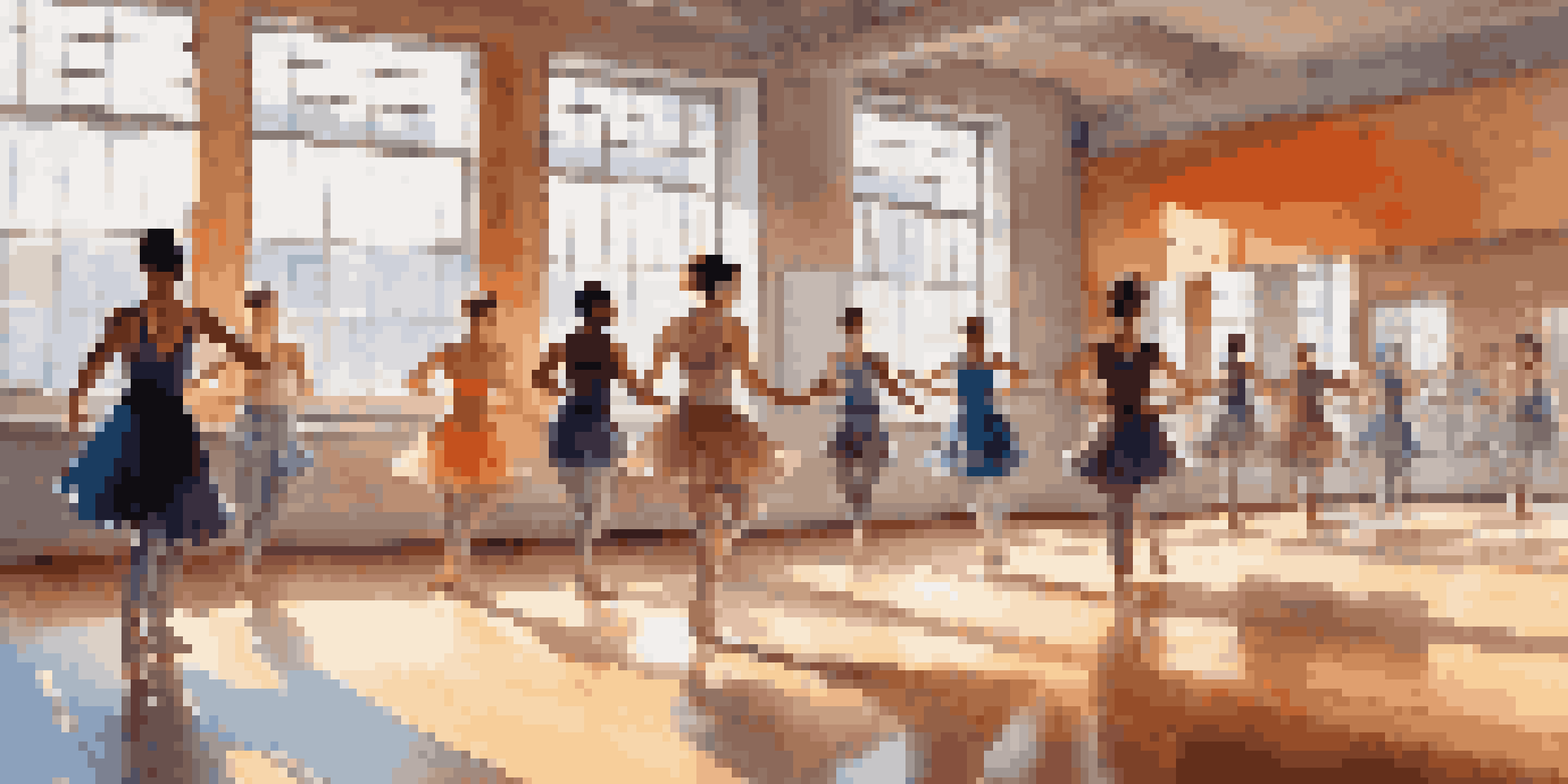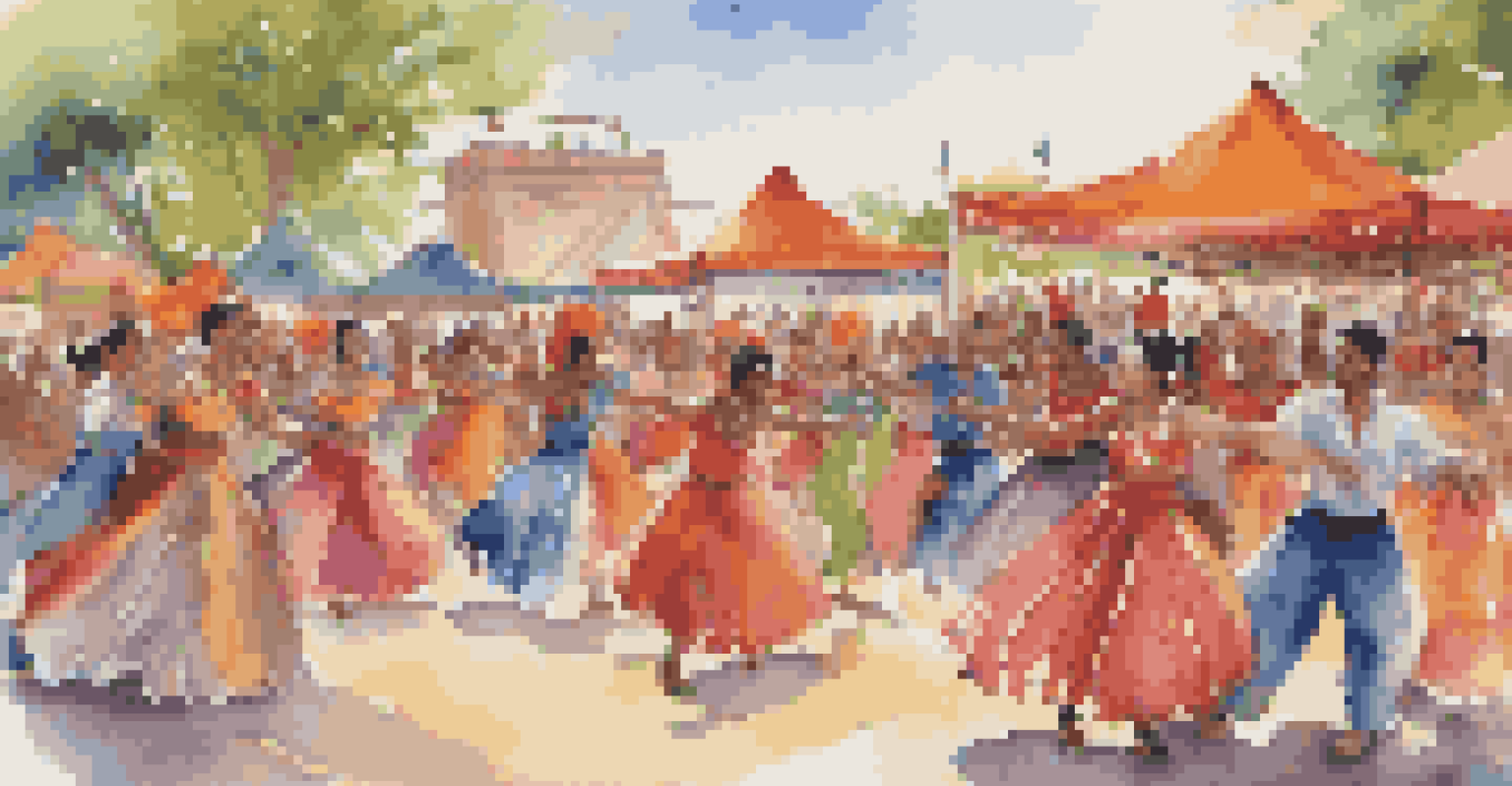Dance Education: Traditional vs. Contemporary Pedagogy

Understanding Traditional Dance Education Approaches
Traditional dance education often emphasizes classical techniques and structured routines. This approach typically focuses on established styles, such as ballet or folk dance, where students learn through repetition and disciplined training. In these settings, the instructor plays a central role, guiding students through a predetermined curriculum.
Dance is the hidden language of the soul.
One of the key benefits of traditional pedagogy is the deep appreciation it fosters for the history and cultural significance of dance. Students often explore the origins of various dance styles, gaining insight into their evolution and cultural relevance. This historical context can enrich the student’s understanding and appreciation of the art form.
However, traditional methods may sometimes limit creative expression, as students are encouraged to adhere closely to established techniques. While this can instill a strong foundation, it might also create barriers for those who wish to explore their own artistic voice. Balancing structure with creativity is an ongoing challenge in traditional dance education.
The Rise of Contemporary Dance Pedagogy
Contemporary dance education has emerged as a response to the rigid structures of traditional methods. This approach often prioritizes creativity and personal expression, allowing students to explore a wider range of movement styles and ideas. In contemporary settings, the focus shifts from technical perfection to improvisation and experimentation.

One significant aspect of contemporary pedagogy is the incorporation of diverse dance styles and cultural influences. Students might find themselves learning hip-hop, jazz, or even dances from various cultures, broadening their skill set and fostering inclusivity. This diversity allows for a richer, more dynamic learning environment where students feel empowered to express their individuality.
Traditional vs. Contemporary Dance
Traditional dance education emphasizes structured techniques, while contemporary approaches prioritize creativity and personal expression.
Additionally, contemporary methods often embrace technology and collaborative learning. Online resources, social media platforms, and collaborative projects can enhance the learning experience, making it more interactive and engaging. By blending traditional techniques with modern influences, contemporary dance education offers a holistic approach to training.
Key Differences: Structure vs. Flexibility
One of the most notable differences between traditional and contemporary dance education is the level of structure involved. Traditional methods typically adhere to a strict curriculum, where each class builds upon the last in a linear fashion. This can create a clear path for learning but may sometimes stifle a student's unique creative journey.
The dance is a poem of which each movement is a word.
In contrast, contemporary pedagogy embraces flexibility, allowing students to explore various styles and techniques at their own pace. This adaptability can lead to a more personalized learning experience, where students feel encouraged to push boundaries and innovate. The environment is often more fluid, fostering collaboration and peer feedback.
Ultimately, the choice between these approaches may depend on a student's personal goals and learning style. Some may thrive in a structured environment, while others may seek the freedom that contemporary methods provide. Understanding these differences can help aspiring dancers make informed decisions about their education.
Cultural Context in Dance Education
Cultural context plays a significant role in shaping both traditional and contemporary dance education. Traditional methods often reflect the cultural heritage from which they originate, teaching students about the values and stories embedded in their dance forms. This connection to culture can deepen a dancer's appreciation for their art.
Conversely, contemporary dance education actively seeks to incorporate multiple cultural perspectives. With globalization, dancers are exposed to a melting pot of styles and techniques, encouraging them to learn from diverse traditions. This cultural exchange not only enriches their training but also promotes a sense of unity among dancers worldwide.
Cultural Context Enriches Learning
Understanding the cultural backgrounds of dance styles enhances appreciation and fosters a more inclusive environment.
Understanding these cultural contexts can enhance a dancer's performance and creativity. Whether they are rooted in tradition or contemporary practices, dancers can draw inspiration from their backgrounds and those of others, fostering a richer artistic expression. Celebrating diversity in dance education cultivates a more inclusive environment for all.
The Role of Technology in Modern Dance Education
Technology has transformed many aspects of education, and dance is no exception. In contemporary dance pedagogy, technology serves as a powerful tool for both teaching and learning. Video tutorials, online classes, and social media platforms allow students to access a wealth of resources, expanding their learning beyond the studio.
For instance, students can now watch performances from around the world, gaining inspiration and insight from various styles and techniques. This access to diverse content can motivate dancers to experiment with their own choreography and movement vocabulary. Moreover, technology enables connectivity with peers and instructors, fostering a sense of community even in virtual spaces.
However, while technology offers many benefits, it also poses challenges, such as the risk of over-reliance on screens rather than physical practice. Striking a balance between technological engagement and in-person training is crucial for developing well-rounded dancers. Navigating this balance will be key to the future of dance education.
Assessment Methods in Traditional vs. Contemporary Dance
Assessment in traditional dance education typically involves structured evaluations focused on technique, performance, and adherence to established styles. Instructors may use standardized criteria to assess students, emphasizing their ability to replicate movements accurately. This method can provide clear benchmarks for progress but may overlook individual creativity.
On the other hand, contemporary pedagogy often embraces more holistic assessment methods. Instructors may evaluate students based on creativity, improvisation, and collaborative projects, allowing for a broader understanding of a dancer's abilities. This approach not only acknowledges technical skills but also values personal expression and artistic growth.
Technology Transforms Dance Education
The integration of technology in dance education facilitates access to diverse resources and fosters community among students.
The challenge lies in finding assessment methods that accurately reflect a dancer's progress and potential. Both traditional and contemporary approaches have their merits, and blending elements from each could create a more comprehensive assessment framework. Ultimately, the goal should be to encourage growth while celebrating each dancer's unique journey.
Future Trends in Dance Education
As the world of dance continues to evolve, so too will the methods of education. The blending of traditional and contemporary practices is likely to become more common, creating a richer learning experience for students. This fusion can help dancers develop both technical skills and personal artistry, preparing them for a diverse and dynamic industry.
Moreover, there is a growing emphasis on inclusivity and accessibility within dance education. Programs that cater to diverse populations and adaptive learning methods are on the rise, ensuring that dance is available to everyone, regardless of background or ability. This trend reflects a broader societal shift toward embracing diversity and equity in the arts.

Finally, the integration of technology will likely continue to shape dance education in innovative ways. From virtual reality experiences to online mentorship programs, the possibilities are endless. As educators and students navigate these changes, the future of dance education promises to be exciting, inclusive, and more connected than ever before.